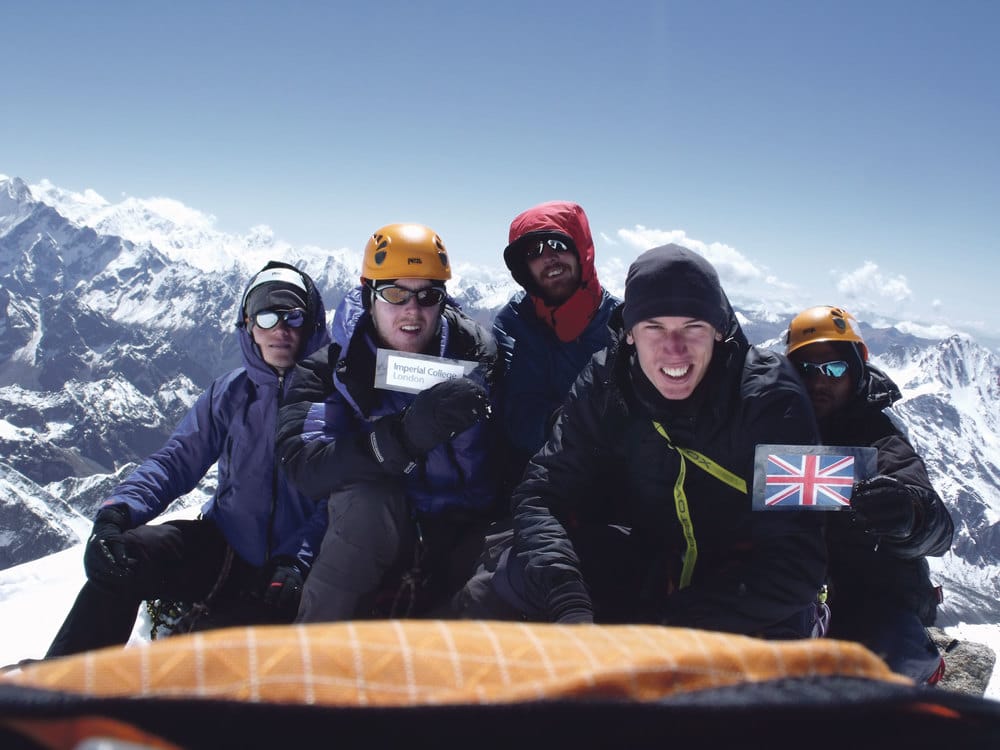Imperial students make mountaineering history
In September, five students summited three unconquered Himalayan mountains. Here’s their first-hand account

On day 6 of our mountaineering expedition to India’s Obra Valley we were sat outside a small wooden hut, our 200 kg of equipment nestled under its overhanging roof, participating in perhaps the most tenuous game of eye-spy ever played. We had spent the last four days traveling north from Delhi, of which the first 600km were easily dispatched by the New Delhi – Dehra Dun Shatabdi Express train. We had sped along the recently burst banks of the Yamuna river and looking out across the dark red and green landscape, barely illuminated by the metallic grey sky, we didn’t think twice about the road ahead. With a mere 100km by jeep left, that we would cover in 6-7 hours, we realised we had underestimated the destructive power of the monsoon rains. The ‘road’ we were to follow to the road head didn’t live up to its name. We found it was blocked in sections, by vast landslides of shale, saturated mud and truck-sized boulders, or in the worst cases, reduced to a single precarious strip of earth, the remnants of the highway strewn across the slopes below. Three days later we finally made it through, and now we were sat, hiding from the rain, next to a wooden hut, playing eye spy, waiting to meet our in-country team. Silently hoping that the overall situation was about to improve, it finally did. Norbu and Darwa had arrived, along with the rest of our 9-strong base camp team. A series of clipped commands from these two hardy Sherpas and half a ton of base camp supplies were unloaded, tents erected and chai served.
Three days of trekking later and we were settling into our base camp, located beside a meander in the glacial torrent of the Obra Gad (river). At just under 4,000m (13,000 ft) we could feel the effects of altitude, although low clouds had so far prevented us from getting a good look at our climbing objectives. A reconnaissance was needed and so we left camp to explore the valley floor and the access to a high glacier, which we believed would enable access to the valley’s highest peak – Dauru, at 5,877m. After exploring a rocky spur and establishing a gear cache we left all but the essentials and returned to base to prepare a multi-day outing. Unsure of conditions higher up we packed loads to deal with any eventuality and once again headed up the valley. Carrying a load up to 4,900m we made a second cache in what we considered to be a good campsite at the edge of a glacier, a safe distance from crevasses and avalanche prone slopes. To aid acclimatisation, we descended for a final night of sleep in the valley before moving our tents up to our high camp, rising early the next morning to make the first ascent of Peak 5,480m at the back of this hanging valley. The going was difficult in soft, fresh snow, mixed with the occasional rocky step but we were rewarded with our first peak of the trip and a fantastic view of the potential route up Dauru – it looked entirely achievable!
After a second night up high we returned to base to spend a rest day bouldering and reconnoitering an approach to another mountain of interest – Ranglana, 5,554m. With a resupply of food we made a push up to, and past, our previous high camp and pitched tents at 5,175m, close to the valley headwall. An early start the next morning and some cold climbing up the headwall gained a narrow col that would give access to the upper slopes of Dauru. After a close call with a collapsing cornice (a wind-sculpted, overhanging edge of snow) we decided that following the ridge directly to the summit would be rather dangerous, and instead made an ascending traverse of the mountain’s North West flank. Reaching the 5,877m summit under clear skies we were afforded spectacular views across not only the Obra Valley, but of hundreds of snowcapped peaks (many still unclimbed) to the North, South, East and West. After many panoramic and group photographs were taken we began the 2,000m (vertical) descent to base, pausing to clear our camp, returning just after nightfall to enjoy yet another excellent meal.
By this point in the expedition our thoughts were turning to the journey back out - our latest update revealed that since our arrival, conditions had worsened in the proximity of Jakhol and we would need to allow extra time on the walk out. The consequence, fewer remaining climbing days than we had hoped, and one major objective still unattempted: The majestic Ranglana. We knew the peak had been attempted at least twice previously and on visual inspection its northern aspect of steep face and complex ridges appeared to be a major mountaineering challenge. After studying the map of the area we believed the key to a rapid ascent was in accessing a col at the base of the mountain’s West ridge. Leaving base camp in the afternoon we approached the mountain and established a camp below this col (4,800m). With the end of the day fast approaching, Andy and Phil ascended to the col and immediately realised that the West ridge, although appearing climbable, would require more time than we could possibly commit. Disappointment? No, by descending from this point we could gain the South face and from there follow a ridgeline directly to the summit! Another early start and we were on our way to the opposite side of the mountain; baked by the sun we made slow progress until gaining the ridge, and a breeze. Some steep snow slopes led to a few rocky steps as we neared the narrow summit. After some attempts we eventually found the line of weakness to the summit and Jonny led up to the top across snow covered slabs, completing our Obra Valley hat-trick. With some light clouds building we took the obligatory photos and began a largely uneventful descent back to our camp. Uneventful, except of course for Phil managing to step into a deep hole filled with powder snow. The consistency and effect was similar to quicksand and so a quick digging operation was required to free him. A final night was spent in our cold mountain tents before we could descend back to the warmth of base camp and prepare for our withdrawal from the valley.
Our retreat from the Himalaya was, thankfully, much more straightforward than our approach. With the assistance of about 15 porters we carried the gear out on foot for two days before once again meeting our jeep, and on the third day were able to make Dehra Dun. A day was spent sampling local fruit and greasy treats, followed by a sleeper train to Delhi, giving us a full day to enjoy the track cycling and athletics at the Commonwealth Games.
The Imperial College Obra Valley Expedition consisted of Boris Korzh, Philip Leadbeater, Kunal Masania, Andrew McLellan and Jonathan Phillips and was supported by the Imperial College Exploration Board, Mount Everest Foundation, British Mountaineering Council, Welsh Sports Association, Lyon Equipment Award, SIS (Science in Sport) Ltd, PHD. Gratitude is expressed to Dominic Southgate, Outdoor Club, Mountaineering Club and Recreational Clubs Committee for the loan of equipment.








